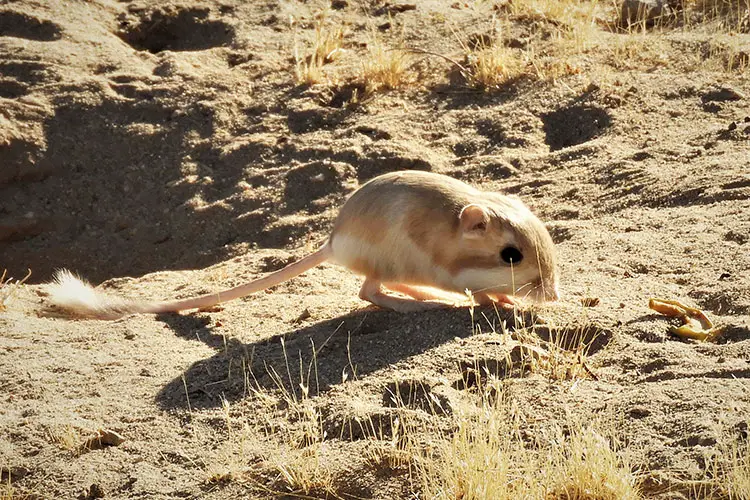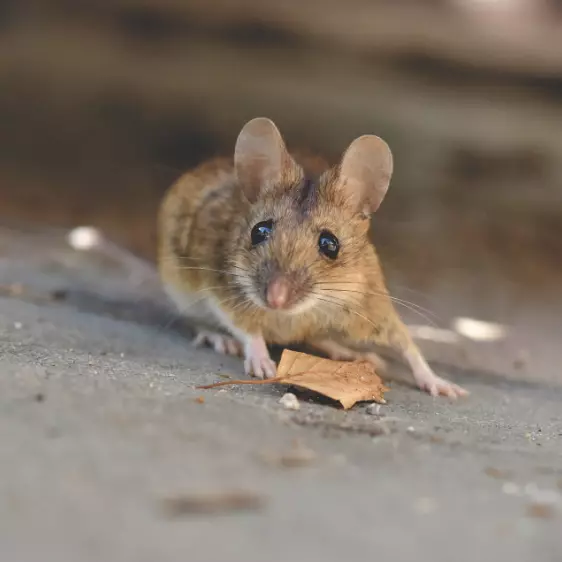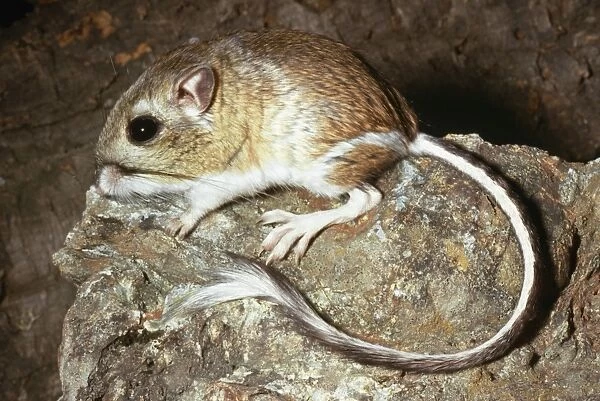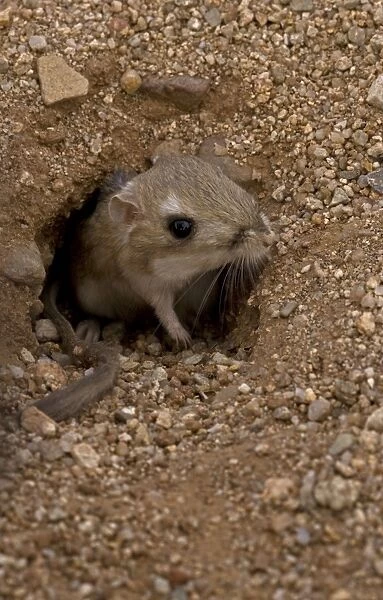
The Kangaroo Rat, also known as Dipodomys, is from the family of small rodents found in the deserts of North America. These rats have adapted to live in arid environments and have unique characteristics that enable them to survive with very little water. One of the most interesting aspects of the Kangaroo Rat is their diet.
Despite their small size, Kangaroo Rats are omnivores and eat a variety of foods. They feed on seeds, fruits, insects, and even small reptiles. In a year, due to changes in seasons their diet varies depending on seasonality factors and availability of food. During the dry season, they rely heavily on seeds and insects, while in the wet season, they consume more fruits and green vegetation. Join Critter Stop and learn with us in detail what the Kangaroo Rat eats and how they have adapted to their environment to survive.

Kangaroo rats are small, bipedal rodents that are found in the deserts of North America. They are named after their unique way of moving, which resembles that of a kangaroo. These rats have long, powerful hind legs, giving them the capability of jumping 9 feet in a single leap. They are primarily nocturnal and are known for their ability to survive in harsh desert environments.
Different species of kangaroo rats
There are over 20 different species of kangaroo rats, each with their own unique characteristics. The most common species include the Merriam's kangaroo rat, the Giant kangaroo rat, and the San Joaquin kangaroo rat. While they all share similar physical traits, such as their long tails and large hind feet, each species has adapted to its own specific habitat and diet.
Habitat and Distribution
Kangaroo rats are found throughout the deserts of North America, including the Mojave, Sonoran, and Chihuahuan deserts. They prefer sandy, open areas with little vegetation and are often found living in burrows, which are their natural habitat that provide protection from predators and help regulate the rat's body temperature in the extreme desert climate.
Unique adaptations
Kangaroo rats have several unique adaptations that help them survive in the harsh desert environment. Most notable adaptation they have is the ability to survive without drinking water. One of the main ways they obtain moisture is though the seed and vegetation they consume. Additionally, kangaroo rats have specialized kidneys that allow them to excrete concentrated urine, further conserving water.
Another unique adaptation of kangaroo rats is their cheek pouches. These pouches, located in their cheeks, allow them to store food for later consumption. This is particularly useful for kangaroo rats, as food can be scarce in the desert environment.
Overall, kangaroo rats are fascinating animals with a variety of unique physical characteristics and the way they adapt, which help them them to thrive in harsh environment like the desert.
Kangaroo rats are primarily herbivores, meaning they feed mostly on plant material. This is the main ability to survive in harsh environments, in which food and water are scarce.. As a result, kangaroo rats have adapted to eat a variety of seeds and plant parts that are high in nutrients and moisture.
Primary Food Sources
The primary food sources for kangaroo rats are seeds, such as those from grasses, shrubs, and cacti. They also eat fruits, leaves, and stems from various plants. Kangaroo rats are known to be selective feeders, choosing seeds and plants that are high in energy and moisture content.
Water Needs and Sources
Kangaroo rats have unique adaptations that allow them to obtain water from their food and to conserve water in their bodies. They are able to extract moisture from the seeds they eat and can survive for long periods without drinking water. When water is available, they will drink from various sources, such as dew, rain, and standing water.
Unique Dietary Adaptations
Kangaroo rats have several unique dietary adaptations that allow them to survive in harsh environments. One adaptation is their ability to digest and utilize the nutrients from seeds that are normally indigestible to other animals. Another ability they have, as certain wildlife, is they excrete very concentrated urine, which allows them to conserve water. Additionally, kangaroo rats have a specialized organ called the cecum, which allows them to ferment and break down cellulose from plant material.
In conclusion, the kangaroo rat's diet and feeding habits are specialized to allow them to survive in arid environments. They primarily feed on seeds and plant material, and can obtain water from their food and various sources. Their unique adaptations enable them to extract nutrients and conserve water, making them well-suited for life in the desert.

Kangaroo rats are primarily seed-eaters, and their diet consists mainly of seeds from various desert plants. They have a unique ability to survive in arid environments where water and food resources are scarce. Kangaroo rats have evolved to be highly efficient at extracting the maximum amount of nutrition from seeds, which helps them to survive in harsh desert conditions.
Types of seeds consumed
Kangaroo rats are known to consume a wide variety of seeds, including those from creosote bush, mesquite, and various grasses. They prefer seeds that are high in fat and protein and low in fiber. The seeds they consume are often hard and require strong teeth to crack open.
How kangaroo rats locate and gather seeds
Kangaroo rats have excellent hearing and can detect the sound of seeds falling from plants. They’re able to locate seeds buried in the ground, due to a keen sense of smell. Once they locate a seed, they use their sharp teeth to crack open the hard shell and extract the nutritious kernel inside.
Storage of seeds for future consumption
Kangaroo rats have adapted to the desert environment by developing a unique way of storing seeds for future consumption. They have specialized cheek pouches that they use to transport seeds to their burrows. Once they have collected enough seeds, they store them in underground storage chambers. These chambers are lined with dry grass and other materials that help to keep the seeds dry and prevent them from spoiling.
The importance of seeds in their diet
Seeds are a crucial component of the kangaroo rat's diet, and they rely heavily on them for their survival. Being a very agile wildlife, has given them a natural ability to extract the nutrition from seeds in harsh environments like the desert.. Without seeds, kangaroo rats would struggle to find enough food to survive, especially during times of drought or low seed availability.
Overall, the seed-eating behavior of kangaroo rats is a fascinating adaptation to life in the desert. Their unique abilities to locate, gather, and store seeds have allowed them to thrive in a harsh environment where few other animals can survive.

Explanation of occasional foliage consumption
Kangaroo rats are primarily granivorous, meaning they primarily feed on seeds. However, they have been observed to occasionally consume foliage as well. Not a common behavior for these animals, but it does happen from time to time.
Types of plants and leaves consumed
When kangaroo rats do consume foliage, they tend to prefer succulent plants such as cacti. They have also been known to eat leaves from shrubs and trees, particularly during periods of drought when other food sources are scarce.
Circumstances under which kangaroo rats eat foliage
Kangaroo rats may consume foliage when their usual food sources are not available, such as during droughts or after wildfires. They may also eat foliage as a supplement to their diet during periods of high energy demand, such as when they are raising young.
How foliage contributes to their overall nutrition
While foliage is not a primary food source for kangaroo rats, it can provide important nutrients such as water, fiber, and vitamins. Consuming foliage may also help kangaroo rats maintain their overall health and energy levels when their usual food sources are limited.
Overall, while foliage consumption is not a primary behavior for kangaroo rats, it can play an important role in their survival during times of scarcity or high energy demand.
Changes in the kangaroo rat's diet throughout the year
The kangaroo rat's diet varies throughout the year, depending on the availability of food. During the summer months, when seeds and green vegetation are abundant, they primarily feed on seeds, leaves, and stems of various plants. In contrast, during the winter months, the kangaroo rat's diet consists mainly of insects, such as beetles, grasshoppers, and crickets, as well as seeds and tubers that they have stored from the previous season.
Adaptations to food scarcity during certain seasons
During periods of food scarcity, the kangaroo rat has several adaptations to help it survive. One adaptation is that they can lower their metabolic rate, which allows them to conserve energy and survive on less food. Additionally, they have specialized kidneys that allow them to extract water from their food, reducing their need for drinking water.
Behavioral strategies for coping with changing food availability
Kangaroo rats have several behavioral strategies for coping with changing food availability. They are known to hoard food, storing seeds and tubers in underground burrows. This allows them to have a supply of food during periods of scarcity. They also have a nocturnal lifestyle, which helps them avoid predators and conserve energy during the hot summer months when food is scarce.
In conclusion, the kangaroo rat's diet varies throughout the year, and they have several adaptations and behavioral strategies to cope with changing food availability. By hoarding food, lowering their metabolic rate, and extracting water from their food, they can survive in the harsh desert environment.

Throughout this article, it has been established that the kangaroo rat is a small, nocturnal rodent that is native to the southwestern United States. The kangaroo rat is known for its unique adaptations, including its powerful hind legs that allow it to hop like a kangaroo. It is also known for its ability to survive in arid environments, where food and water are scarce.
The kangaroo rat is an herbivore and primarily feeds on seeds, grasses, and other vegetation. It has been observed to store food in its burrows for later consumption, which allows it to survive during times of food scarcity.
Understanding the kangaroo rat's diet is crucial for several reasons. First, it allows us to better understand the ecological role that the kangaroo rat plays in its ecosystem. As an herbivore, the kangaroo rat helps to disperse seeds and maintain plant populations. Second, understanding the kangaroo rat's diet can help us to better manage and conserve its habitat. By protecting the vegetation that the kangaroo rat relies on for food, we can help to ensure its survival.
In addition, understanding the kangaroo rat's diet can also have implications for human health. Many of the plants that the kangaroo rat feeds on have medicinal properties and may have potential uses in treating human diseases.
Overall, the kangaroo rat's diet is an important aspect of its biology and ecology. By continuing to study and understand this fascinating animal, we can gain valuable insights into the workings of the natural world.
What is the diet of the Kangaroo rat?
The Kangaroo rat is primarily a seed eater. Its diet consists of a variety of seeds, including mesquite beans, creosote bush seeds, and grass seeds. They are also known to eat insects, fruits, and green vegetation when seeds are scarce.
Are Kangaroo rats herbivores or omnivores?
Kangaroo rats are herbivores, meaning they primarily eat plant-based foods. However, they may occasionally consume insects and other small animals when their preferred food sources are scarce.
Do Kangaroo rats eat grasshoppers?
Kangaroo rats are known to eat grasshoppers and other insects when their primary food sources are limited. However, insects are not a significant part of their diet.
Do Kangaroo rats eat sagebrush?
Kangaroo rats are known to eat the seeds of sagebrush, but they do not consume the leaves or stems.
How does the Kangaroo rat obtain water?
Kangaroo rats are adapted to living in arid environments and can obtain most of their water from the metabolic breakdown of the seeds they consume. They are also able to conserve water by producing highly concentrated urine and feces.
What happens if a Kangaroo rat drinks water?
Kangaroo rats are not well adapted to drinking large amounts of water and can become seriously ill or even die if they consume too much water. They are able to obtain most of their water needs from the seeds they eat and do not require additional water sources.
Feel safe and sound from Kangaroo Rats in your neighborhood with the help of Critter Stop, you can contact us at (214) 234-2616 and we gladly get to your home inspect and help you get rid of any Wildlife that keeps you awake at night, our unique methods are safe and humane.
Visit our Critter Library and learn more about our furry friends